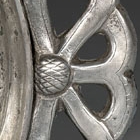J.J. Lally & Co., Oriental Art / New York City, New York
MenuPast Exhibition
Silver and Gold in Ancient China
March 16 – April 14, 2012
35.
A SILVER MELON-SHAPED SMALL BOWL
Yuan Dynasty (A.D. 1271-1368)
of half-melon shape, with a wide handle in the form of a knotted ribbon projecting at one side below the rim, above a small ring applied perpendicular to the side of the bowl, the steeply rounded sides divided into long lobes by deep grooves rising to nodes at either end, resting on a flat oval base, chased with a single large character in lantsa script within a simple scrollwork border on the interior of the base, the burnished surface showing scattered remains of malachite green encrustation.
Length 4 3⁄8 inches (11.2 cm)
Width over handle 5 3⁄8 inches (13.7 cm)
The lantsa character in the center of the bowl may be read as “om,” which is the first character of the Tantric Buddhist mantra “om mani padme hum.”
A very similar melon-shaped silver bowl with knotted ribbon handle and lantsa character, excavated from a Yuan dynasty hoard at Guanwang village, Bazixiao xiang, Yuyang county, Hunan province in 1982, now in the Shanghai Museum, is illustrated in Hunan chutu jinyinqi (Gold and Silver Excavated in Hunan), Changsha, 2009, p. 263, no. 227. Another similar melon-shaped silver bowl with ribbon handle and lantsa character excavated from a Yuan dynasty hoard at Mingjing village, Hongshantou town, Huarong county, Hunan province, is illustrated op. cit., p. 280, no. 244-1.
Compare also the very similar melon-shaped silver bowl with ribbon handle and lantsa character in the Muwen Tang Collection, illustrated by Kwan, Chinese Silver, Hong Kong, 2004, pp. 184-185, no. 87, described as a brush-washer, for use in the scholar’s studio.
元 梵文單耳瓜形銀洗 長 11.2 厘米 寬含把手 13.7 厘米
